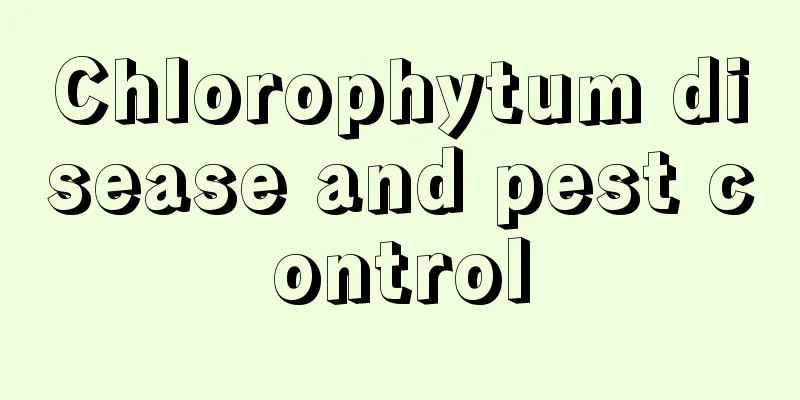Chlorophytum disease and pest control

Disease 1: Root rotDisease patternIt mainly harms seedlings, and mature plants are less likely to become ill. The early symptoms of the plants are not obvious. As the root rot worsens, the roots' ability to absorb water and nutrients weakens, and the above-ground parts begin to turn yellow and wither. In severe cases, all the spider plants will wither overnight. CausesThe soil is too wet and poorly ventilated; the roots are affected by pests and diseases, with many wounds and pathogens invading the plants; insufficient light; the temperature is too low and there is a large temperature difference between day and night. Prevention and treatment measuresDisinfect and sterilize the seeds before sowing, and mix them with a special sterilizer. To disinfect the soil, try to sprinkle 50% of carbendazim on the soil when planting and turn it into the soil. When the disease occurs, the dosage should be increased appropriately. Use 40% root rot Ning to irrigate the roots once a week until improvement is seen. Disease 2: White rotDisease patternThe diseased area is located on the rhizome near the ground of the plant. There are purple-brown spots in the early stage, which gradually spread and cause petiole rot in the later stage. There are many white mycelium layers in the diseased part. CausesHigh temperature and humidity; waterlogging in the soil; poor ventilation and light transmission. Prevention and treatment measuresWater moderately, fertilize appropriately, and don't plant too deep. When planting seedlings, use formalin to fill the soil and disinfect it. In the season when white rot is frequent, irrigate the roots with methyl thiophanate solution. In the early stage of the disease, sprinkle some lime powder around the potting soil, once every 15 days, 2 to 3 times will be enough. Disease 3: Stem rotDisease patternThe disease often occurs in old plants. The stems turn brown, the leaves lose their luster and droop, and the whole plant gradually dies. Once this disease occurs, it is difficult to treat, so prevention is the priority. CausesThe soil is moist; light and ventilation are poor. Prevention and treatment measuresDuring the season when pathogens are most prevalent, keep the soil relatively dry and provide sufficient light and water. Before the season when the disease is most prevalent, try not to divide the plants or repot them to reduce leaf wounds. Use medication regularly for sterilization. Disease 4: AnthracnoseDisease patternMainly harms leaves. In the early stage of the disease, many yellow-brown, slightly sunken spots will appear, which will gradually expand in the later stage. The leaves dry up quickly and in severe cases the entire plant dies. CausesThe environment is stuffy and humid, with poor ventilation; water accumulates in the flower pots and the plants are planted too densely; the leaves are damaged. Prevention and treatment measuresWater at the right time to avoid excessive soil humidity. Apply fertilizer moderately and increase the amount of phosphorus and potassium fertilizers. Ensure good ventilation, remove diseased plants promptly if found, and keep the plants clean. Spray the leaves with Bordeaux mixture to sterilize and disinfect. Disease 4: Pests (nematodes, aphids, beetles)Pests are bacterial infections and should be taken seriously. Prevention and treatment measuresStrengthen water and fertilizer management to enhance the resistance of plants. In the early stage of the disease, there are fewer insects and they can be scraped off manually or rinsed with clean water, but be careful not to damage the leaves. Use insecticide, spray with 1000 times omethoate solution, once every 7 to 10 days, and the disease will be basically cured after 2 to 3 times. |
<<: How to prevent and treat common diseases of chrysanthemum
>>: What to do about Calla Lily Leaf Spot Disease
Recommend
When is the best month to plant snow peas?
When to plant snow peas Snow peas are suitable fo...
How to raise Chinese soft-shelled turtle
The Chinese soft-shell turtle is also known as th...
Curled leaves are so ugly, here's a trick to help you solve it
It's all because of dryness. Many flower love...
Where is the best place for Polygonatum to grow? What kind of soil is suitable for its growth environment?
Where does Polygonatum grow? Polygonatum is suita...
The whole community uses it to grow flowers. Even if we don’t take care of it in January, it will grow wildly all over the balcony!
Can fish tank water be used to water flowers? Whe...
How to grow chrysanthemums in autumn
1. Watering Watering plays an important role in i...
Milan pruning time and method
1. Pruning time It is recommended to prune Milan ...
What flowers are suitable for growing in Beijing?
1. Beijing's climate characteristics Beijing ...
How much is a pound of watermelon? Watermelon photos
1. Price The prices of watermelons vary. Generall...
When does yellow orchid bloom?
1. Flowering time Generally speaking, yellow orch...
How to grow durian in spring
1. Supplementary lighting Adequate light can make...
Pests of Jasmine and Their Control
Pests of Jasmine The main pests of hairy jasmine ...
How to propagate Ruogeshi by cuttings
Cut off the healthy head, and then place it in a ...
How to care for potted roses in winter
Are potted roses afraid of freezing? Potted roses...
Green radish planting methods and precautions
When to plant green radish Pothos can be propagat...









